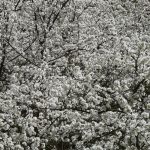The Blackthorn
The Blackthorn

Prunus spinosa
From my window this morning I could see the mountains all covered in snow, and in the valleys below there were drifts of white across the hedgerows – but this wasn’t powdery snow but actually a fine filigree of tiny white flowers of the British Blackthorn
This prolific native tree is still common in our hedgerows and woodland fringes. It was planted in hedges because of its brutally sharp long thorns which helped to deter stock such as sheep and cattle from escaping. Nowadays we rely on fences and barbed wire which makes the lives of other wildlife so difficult – such as foxes, hedgehogs, stoats, weasels, rabbits and of course hares. As a hedging plant the Blackthorn is particularly good for nesting birds as it offers a spikey defence against the common cat
What makes the Blackthorn so special at this time of the year is that it flowers before its leaves come out and therefore creates a delicate display of snow white lace on black thorny stems, worthy of a Japanese flower arrangement
The fruit of the Blackthorn is popular amongst foragers in late Autumn, as it produces a hard round black berry – The Sloe Berry – which makes a delicious Sloe Gin, much needed after getting thoroughly spiked picking the berries
The dark dense wood makes very fine walking sticks and was particularly famous for the Irish Shillelagh. The Shillelagh has a long and involved history in Eire, as the Plaid in Scotland
Irish men would use the Shillelagh, a heavily weighted club with knotty shaft with thorns left on, for self defence or protection or as a weapon. After the Battle of The Boyne in 1690 the Shillelagh was forbidden. Today it is much valued and a few skilled craftsmen still make this stick from the thorny Blackthorn but de-prickled. I remember my father had a beautiful Shillelagh which he highly prized – and I would love one for myself